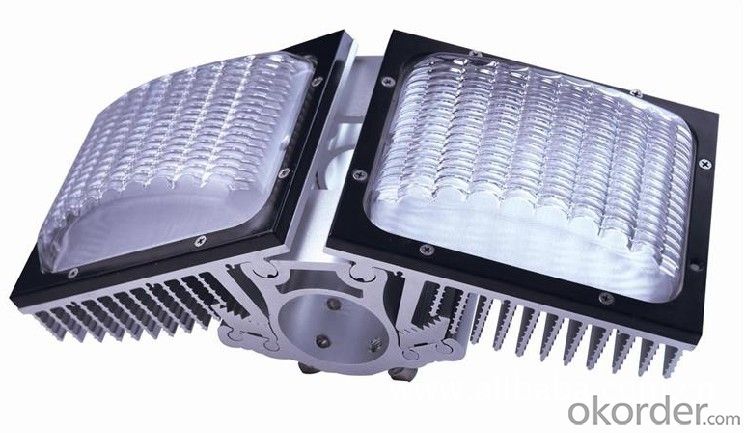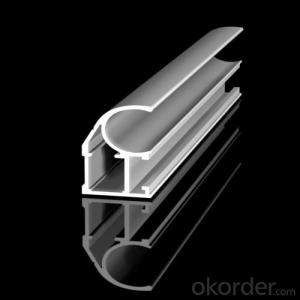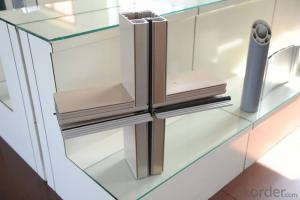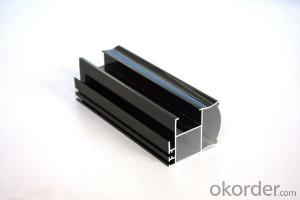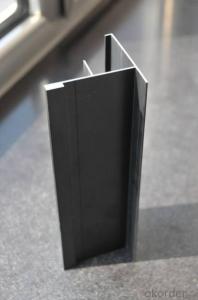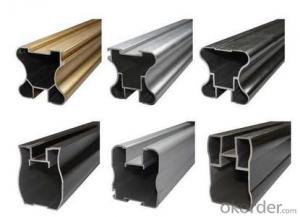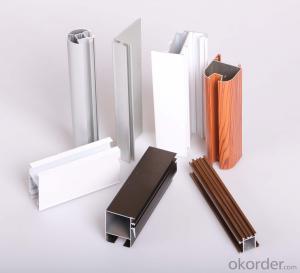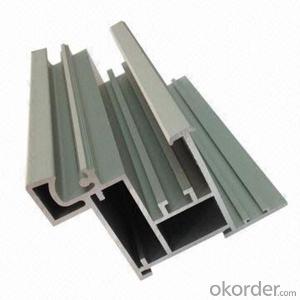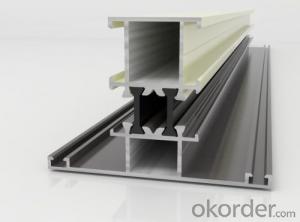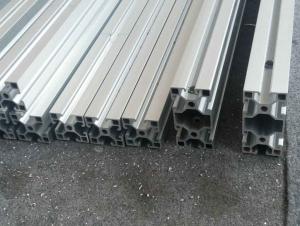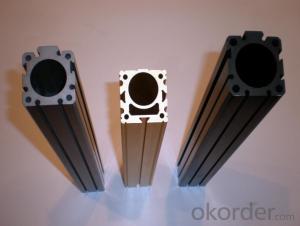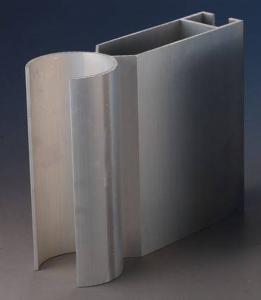Aluminum Alloy Profile Accessories for LED Frame
OKorder Service Pledge
OKorder Financial Service
You Might Also Like
Weare the largest aluminum profile manufacture in
The detail descriptions of aluminum profile as bellowing:
Alloy Aluminum 6063,6061,6005,6082 or customer nominated | |
Temper | T3, T4, T5, T6 and other |
Surface | Anodize, electrophoresis, powder coating, PVDF coating, wood grain painting, etc. |
Colour | Any colour based on Standard Germany RAL Mark |
Length | Not more than 16 meters |
Good Package | Inner plastic film /outside carton/wooden pallets |
Payment Method | T/T, L/C, etc |
Delivery Time | Normally 2-4 weeks, Delivery time can be consulted. |
Press Machine | 500-12500 tons all together 93 press lines. |
Fabrication | 1. LED frame; 2. Drilling; 3. Bending; 4. Cutting; 5. etc. |
Certificate | ISO/TS 16949,DNV,IRIS,CCS,AFA,etc. |
Dies | 1. Using our dies, no fee; |
2. Using customer drawing, opening dies, usually about 5~50 tons then the dies cost can be refunded. | |
3. Die cost is negotiable base on the order quantity | |
Capability | Annual output 800,000 tons |
- Q: Aluminum blackening formula
- Anodic oxidation of aluminum is aluminum or Aluminum Alloy anode to lead as cathode in sulfuric acid, oxalic acid, chromic acid and aqueous solution electrolysis, so that the surface oxide film. The anodic oxidation process is most widely used. Aluminum and Aluminum Alloy sulfuric acid anodizing oxidation film has high adsorption capacity, easy sealing alone or with colored more to improve the corrosion resistance of anodic oxide film thickness and appearance. The process is generally Aluminum Alloy sulfuric acid anodizing electrolyte has the advantages of simple operation, stable, cost is not high, the process is mature, but in sulfuric acid anodized process often unavoidable failure occurred, influence of oxide film quality. The following detailed analysis about the failure reasons, then give some preventive measures for your reference:Common faults and analysisAluminum Alloy products by sulfuric acid anodic oxidation, partial oxidation without touch, showing visible black spots or stripes, film drums or holes. The failure phenomenon of tumor is rare but has occurred.Dr. al website has detailed knowledge
- Q: How do aluminum profiles perform in seismic or earthquake-prone areas?
- Aluminum profiles have proven to be highly effective in seismic or earthquake-prone areas due to their unique properties. The lightweight nature of aluminum makes it a popular choice for construction in such areas as it reduces the overall weight of the structure, thus minimizing the potential for collapse during an earthquake. Additionally, aluminum possesses excellent ductility, meaning it can deform under stress without fracturing, which allows it to absorb and dissipate the energy generated by seismic activity. Moreover, aluminum profiles have high strength-to-weight ratio, allowing them to withstand the dynamic forces exerted during an earthquake. This strength, combined with the material's corrosion resistance, makes aluminum profiles particularly suitable for seismic areas where the risk of structural damage is heightened. Furthermore, aluminum is a highly malleable material, making it easy to shape and fabricate into various structural components. This flexibility allows for the creation of customized designs that can withstand seismic forces. Additionally, aluminum profiles can be easily bolted or welded together, providing a secure and reliable connection that further enhances the structural integrity of the building. It is important to note that the performance of aluminum profiles in seismic areas also depends on the overall design and construction techniques used. Proper engineering practices, such as incorporating seismic bracing systems or using specialized connectors, can further improve the performance of aluminum structures during earthquakes. Overall, due to its lightweight, ductile, strong, and corrosion-resistant properties, aluminum has proven to be a reliable and effective material for use in seismic or earthquake-prone areas. When appropriately designed and constructed, aluminum profiles can significantly enhance the safety and resilience of structures in these challenging environments.
- Q: Is it possible to recycle and reuse aluminum profiles?
- <p>Yes, aluminum profiles can be recycled and reused. Recycling aluminum is an efficient and environmentally friendly process, as it requires significantly less energy compared to producing aluminum from raw materials. Recycled aluminum maintains its properties, making it suitable for various applications. The recycling process involves melting the aluminum, which can then be reformed into new profiles without losing its strength or quality. This practice reduces waste and conserves natural resources, contributing to sustainability efforts.</p>
- Q: This question asks about the various uses of aluminum profiles in the construction of buildings.
- <p>Aluminum profiles have a wide range of applications in building construction due to their strength, durability, and lightweight properties. They are used in window and door frames, curtain walls, and structural glazing systems for their high strength-to-weight ratio and resistance to corrosion. Additionally, aluminum profiles are utilized in the construction of balconies, handrails, and stairways for their ability to withstand harsh weather conditions. They are also employed in the fabrication of modular building systems and prefabricated components, offering ease of assembly and design flexibility. Furthermore, aluminum profiles are used in the construction of solar panel mounting systems and facades due to their thermal conductivity and ability to support heavy loads.</p>
- Q: Are aluminum profiles resistant to mold or mildew?
- Yes, aluminum profiles are resistant to mold and mildew. The inherent properties of aluminum make it highly resistant to the growth of mold and mildew. Unlike other materials such as wood, which can be susceptible to moisture damage and thus promote the growth of mold and mildew, aluminum is not prone to these issues. Additionally, aluminum profiles are often treated with protective coatings or finishes that further enhance their resistance to mold and mildew. This makes aluminum profiles a suitable choice for areas that are prone to high humidity or moisture, such as bathrooms or kitchens, where the growth of mold and mildew is a common concern.
- Q: This question asks for the standard specifications and measurements of aluminum profiles that are frequently utilized in construction projects.
- <p>Aluminum profiles used in construction come in various specifications and measurements. Commonly, they are categorized by series such as 6060, 6061, 6063, and 6082, each with different mechanical properties. Sizes can range from small profiles like 20x20mm to large ones like 200x200mm or more. Thicknesses typically vary from 1mm to 6mm, depending on the structural requirements. Lengths can be customized but are generally available in standard lengths such as 6 meters. The profiles are measured in terms of their width, height, and thickness, and they are designed to meet specific load-bearing and aesthetic needs in construction. It's important to consult with suppliers or construction specifications for the exact measurements required for a particular project.</p>
- Q: Can aluminum profiles be used for soundproofing or acoustic applications?
- Indeed, soundproofing or acoustic applications can make use of aluminum profiles. Aluminum is renowned for its remarkable ability to dampen sound, rendering it a perfect material choice for constructing sound barriers or enclosures. Its robust structural properties and capacity to either absorb or reflect sound waves effectively diminish noise transmission. Moreover, aluminum profiles can be readily tailored and manufactured into various forms and dimensions to cater to specific acoustic needs. Whether employed in walls, partitions, doors, or enclosures, aluminum profiles play a significant role in reducing sound transfer and creating a more tranquil and pleasant atmosphere.
- Q: This question asks for guidance on selecting the appropriate aluminum profile for a construction project.
- <p>To choose a suitable aluminum profile for your building project, consider the following: First, assess the structural requirements such as load-bearing capacity and span. Second, consider the aesthetic preferences and the desired finish or color. Third, evaluate the environmental conditions the profile will be exposed to, such as weather resistance and corrosion. Fourth, consult with suppliers or manufacturers for technical specifications and recommendations. Fifth, ensure compliance with building codes and standards. Finally, factor in the cost and availability of the profiles. It's often helpful to consult with engineers or architects who can provide expert advice tailored to your specific project needs.</p>
- Q: Regarding the wall thickness of aluminum alloy profiles, are there any standards in the country?
- For the main force components of aluminum alloy curtain wall, such as column, transverse material and so on. Such as closed hollow profiles, the wall thickness of not less than 3mm, if the solid section (or known as non closed profiles), the wall thickness of not less than 2.5mm. The state has standards for curtain walls.
- Q: Are aluminum profiles energy-efficient?
- Yes, aluminum profiles are energy-efficient. Aluminum is a highly conductive material, allowing for efficient heat transfer and reducing energy losses. It is also lightweight, making it easier to transport and install, saving energy in the process. Additionally, aluminum profiles can be designed with thermal breaks or insulation to further enhance their energy efficiency.
Send your message to us
Aluminum Alloy Profile Accessories for LED Frame
OKorder Service Pledge
OKorder Financial Service
Similar products
Hot products
Hot Searches
Related keywords

